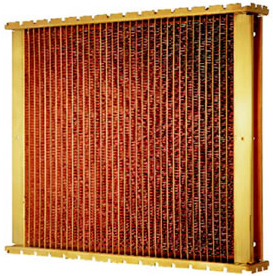Heat Transfer Boosted By Copper
 Radiators, like this CuproBrazeTM, copper model, will become even more efficient with the commercialization of much-more-efficient coolants called "nanofluids". The copper-containing fluid could also advance the design of internal-combustion engines and the vehicles they power; radiators and engines could be made smaller and lighter, yet deliver the same horsepower. (Photo courtesy of SHAZZ.)
Radiators, like this CuproBrazeTM, copper model, will become even more efficient with the commercialization of much-more-efficient coolants called "nanofluids". The copper-containing fluid could also advance the design of internal-combustion engines and the vehicles they power; radiators and engines could be made smaller and lighter, yet deliver the same horsepower. (Photo courtesy of SHAZZ.)Automotive radiators depend on antifreeze to help transfer heat and keep your car running cool. A new heat transfer fluid, ten years in development, contains copper and promises to significantly increase cooling efficiency.
A "nanofluid" using copper particles less than 10 nanometers in diameter is being developed by a five-man team at Argonne National Laboratory (Illinois). The team, headed by principal investigator Dr. U.S. Choi, hopes their improved fluid will be commercialized in the coming years, enabling smaller and lighter heat transfer units to be used in many industries.
Only a very small amount by volume of the tiny copper particles is required-less than three tenths of one percent. The particles work because they have such an enormous surface area to volume ratio, according to Choi, a specialist in heat transfer.
Previous unsuccessful attempts to introduce metal particles in heat-transfer fluids used micrometer-size particles. But much smaller nanometersize particles having 1,000 times the surface area to volume ratio are proving to work well. In addition, a small amount of thioglycolic acid is needed to raise the thermal conductivity. The acid also helps prevent settling of the particles.
At first, the team tried particles of the oxides of copper and aluminum. These raised the thermal conductivity of the fluids by 20% at a particle concentration of 4% by volume. When pure-copper nanocrystalline particles were substituted, the fluid's thermal conductivity increased by 40%.
The copper particles are introduced by the direct condensation of metallic vapor by contact with a flowing, lowvapor- pressure fluid. Very little undesirable agglomeration (sticking together) of the particles results. There is minor deterioration in thermal conductivity over time.
Nanofluids Now Patented
Choi and one of his colleagues, J. A. Eastman, hold a patent on this advance. They are in contact with leading manufacturers of coolants to commercialize nanofluids. This could take as long as five years.
High-thermal-conductivity coolants should enable manufacturers of vehicles to reduce the size of their engines (smaller channels for the fluid). Radiators could be shrunk as well, enabling greater streamlining. Other potential applications are in large heating and air conditioning systems, in commercial preparation of foods and beverages and especially in cooling nuclear reactors and ever-more-compact supercomputers.
Apossible technical obstacle is electrolytic action between the suspended copper particles and other metals in the heattransfer systems. Dr. Choi noted that this would be less of a problem in vehicle radiators made of copper or brass.
Argonne: 630/252-2000
Also in this Issue:
- It Takes a Lot of Brass to Make Good Music
- Lightweight Copper Cladding
- Copper Alloys Go Golfing with the Pros
- Copper Garage Doors Add Style
- "W" Energized By The Sun
- Heat Transfer Boosted By Copper
- 100 Years Of Copper Rivets
- Copper Enhances Indoor Waterfalls
